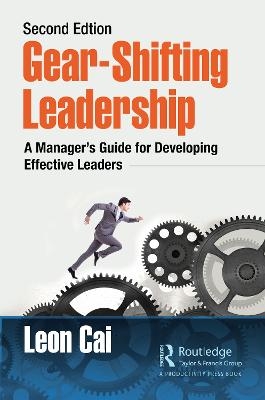
Gear-Shifting Leadership
CRC Press (Verlag)
978-0-367-82032-9 (ISBN)
Gear-Shifting Leadership, now in its Second Edition, is a book designed to improve leadership ability of practicing managers and addresses the full spectrum or panorama of what is expected from successful leaders. Managers need to grasp more than just one or two aspects of leadership, but the whole content and complete framework of it. Gear-Shifting Leadership, Second Edition provides the concepts, tools, and examples needed for managers to become effective leaders.
Updated with new examples and tools, this second edition of Gear-Shifting Leadership synthesizes dozens of leadership models, and fully displays "the panorama of leadership." The author demonstrates the panorama by showing the links and connections between different parts of leadership. The book displays the four gears and nineteen components of leadership managers need to develop. The four gears are: Followership, Face-to-face Leadership, In-Direct Leadership, and Organizational Executive Leadership.
• Followership refers to the ability of leaders to win the trust from subordinates, superiors, and counterparts through demonstrative self-management.
• Face-to-face Leadership demonstrates the leaders’ ability to drive, encourage, instruct, manage, control, and develop direct subordinates and core teams. It exhibits leaders’ one-on-one leadership abilities targeted at their direct subordinates.
• Indirect Leadership shows the leaders’ influence and driving power towards indirect subordinates and the whole team, and it can be defined as the leaders’ role in managing the team as a whole.
• Organizational Executive Leadership shows leaders’ acute insight of the dynamic changes in their organizations, and the leaders’ ability to optimize their own approach to managing the team and in so doing, adapt to changes in both the internal and external environment of organizations.
The book walks readers through each gear as well as the several components it comprises. Many leadership books have excellent concepts and ways of thinking, but lack practical sheets, models and tools, so that books of this type can only improve leaders themselves and can’t be widely used in their organizations. Gear-Shifting Leadership illustrates the model, tables, evaluation questionnaires, and simplified tools that will make the material in this book practical and applicable.
Leon Cai is a global partner of Perth Leadership Institute and represents Perth in Shanghai, China. He is also the Dean as well as Chief Consultant of Wilner Sales & Leadership Institute. Leon was once ranked among the top ten most influential Chinese trainers and was the winner of the "Honor China Award". He was recommended by the Discovery Channel of CCTV (Central TV station of China) as a leading figure in China’s training and consulting industry. Leon Cai graduated from Fudan University, a top-level university in China. He had been a management consultant in a renowned consulting firm and a senior marketing director in a fortune 500 company before starting his career as a trainer, speaker and writer. He was certified as "writer of the year" by Enterprise Management Publishing house as well as China Fortune Press. Leon Cai is the author of many bestsellers in China. Besides Gear-shifting Leadership, he has also published Key Controlling Points of Sales Management; Soft Negotiation; Blue Marketing, Red Sales; Left -Hand Service, Right-Hand Sales; and Strategic Selling.
Contents
About the Author ................................................................................... ix
Preface .................................................................................................... xi
Introduction: Four Gears of Leadership Development .... 1
Mid- and High- Level Managers Need More
Comprehensive Leadership ...................................... 1
Four Gears of Leadership Development ........................... 2
PART I Followership
Chapter 1 Followers and Leaders ........................................................ 9
Why Should Leaders Develop Followership? ................... 9
The Basic Definition and Connotation of
Followership ............................................................ 11
Interaction Between Followers and Leaders ................... 12
Chapter 2 Two Cores of Followership .............................................. 19
5Q Model of Leaders’ Self- Management ......................... 20
Seven Laws of Leaders’ Upward Management ................ 24
PART II Face- to- Face Leadership
Chapter 3 Four Driving Wheels of Face- to-Face Leadership .......... 33
The Four “Don’t Know” Root Causes of
Performance Gap .................................................... 35
Four Driving Wheels of Face- to-Face Leadership .......... 35
Chapter 4 Face- to- Face Leadership— Boundary- Defined
Delegation ......................................................................... 41
Form Closed Loops of Execution Through
Effective Delegation ................................................ 41
Boundary- Defined Delegation ........................................ 42
Guard Against Anti- Delegation from
Subordinates ............................................................ 48
Chapter 5 Face- to- Face Leadership— Inner- Driven Motivation ..... 51
Inner- Driven Motivation versus Material Incentive ...... 51
Four Types of Inner Drive ............................................... 52
Chapter 6 Face- to- Face Leadership— Dual- Track Mentoring ......... 57
Two Major Tracks of Subordinate’s Ability ..................... 57
Forms and Rules of Perfect Coaching ............................. 58
Modes and Principles of Effective Counseling ............... 63
Chapter 7 Face- to- Face Leadership— Preventive Intervention ....... 67
Behavioral Intervention versus Performance
Assessment ....................................................................... 67
Five Murphy’s Behaviors in Urgent Need of
Intervention ............................................................ 69
Seven Golden Steps of Intervention Interview ............... 71
PART III Indirect Leadership
Chapter 8 Three Major Roles of Indirect Leaders ........................... 79
Upgrade from Face- to- Face Leadership to Indirect
Leadership ............................................................... 79
WWH Analysis Model of Macro Performance ............... 81
Three Key Roles of Indirect Leaders ............................... 84
Three Performance Indicators of Indirect
Leadership ............................................................... 85
Self- Evaluation Form of Five Leadership Roles .............. 90
How Do the Behaviors in the Following Table
Match Those of Yours? ........................................... 90
Chapter 9 Enhancement of the Centripetal Force of a Team .......... 97
The 3V Tools of Psychological Contract ......................... 97
Vision Anchor ................................................................... 98
Value Root ....................................................................... 103
Victory Chain ................................................................. 108
Chapter 10 Enhancement of the Executive Force of a Team ........... 113
Three Components of the Executive Force
of a Team ............................................................... 113
Absolute Non- Negotiables ............................................. 115
Standard Execution Procedures ..................................... 119
Key Responsibility Matrix .............................................. 128
Chapter 11 Enhancement of the Cohesive Force of a Team ............ 133
Interpersonal Synergy Quotient of a Team ................... 133
Fellowship with Complementary Roles ........................ 137
Informal Group Alliance ................................................ 143
Trust Circle ..................................................................... 149
PART IV Organizational Executive Leadership
Chapter 12 Three Dynamic Optimizations of Organizational
Executive Leadership ..................................................... 157
Three Dynamic Optimizations of Organizational
Executive Leadership ............................................ 159
Dynamic Optimization of Organizational
Talent Pool ............................................................ 161
Dynamic Optimization of Decision- Making Modes ...... 166
Dynamic Optimization of Leadership Styles ................ 173
Conclusion: Learning and Practice of Gear- Shifting
Leadership ....................................................................... 181
Principle 1: Comprehensive Mastery of Gear-
Shifting Leadership ............................................... 181
Principle 2: Weakness Improvement in Gear-
Shifting Leadership ............................................... 182
Principle 3: Prioritized Enhancement in Gear-
Shifting Leadership ............................................... 183
Principle 4: Preparatory Development of Gear-
Shifting Leadership ............................................... 183
Index .................................................................................................... 185
| Erscheinungsdatum | 26.03.2021 |
|---|---|
| Zusatzinfo | 49 Tables, black and white; 20 Illustrations, black and white |
| Verlagsort | London |
| Sprache | englisch |
| Maße | 152 x 229 mm |
| Gewicht | 530 g |
| Themenwelt | Wirtschaft ► Betriebswirtschaft / Management ► Unternehmensführung / Management |
| ISBN-10 | 0-367-82032-3 / 0367820323 |
| ISBN-13 | 978-0-367-82032-9 / 9780367820329 |
| Zustand | Neuware |
| Informationen gemäß Produktsicherheitsverordnung (GPSR) | |
| Haben Sie eine Frage zum Produkt? |
aus dem Bereich


